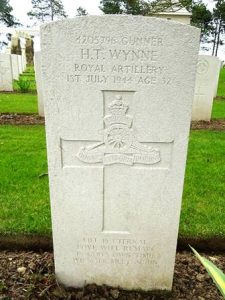Pennal is a village and community on the A493 road from Aberdyfi to Machynlleth, situated on the north bank of the River Dyfi, in the ancient county of Merionethshire. The village lies within the Snowdonia National Park, and is also home to an ancient Roman Fort, which was built to guard the crossing of the Dyfi on the Sarn Helen Roman road. The men of the village who fell during both World Wars are commemorated on the village war memorial, which is situated by the side of the road in the centre of the village. I have also taken the liberty to add the details of an officer from Pennal who died on active service in India in 1904. Next to the war memorial is another memorial to the crew of an RAF aircraft which crashed nearby in 1941. This memorial is on a separate web-page.
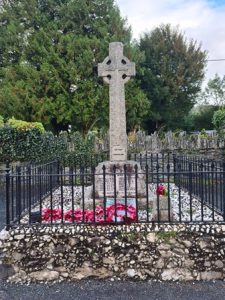
Pre WW1
Reginald George Lascelles, Second Lieutenant, Durham Light Infantry. Reginald was Reginald was born in Pennal on 10 March 1883, the son of John Lascelles and Mary Elizabeth Lascelles (nee Cotton), of Penmaen Dyfi. He was commissioned into the 4th Battalion, Durham Light Infantry (Militia) and served during the Boer War of 1899-1901, before being promoted Lieutenant with the 1st Battalion, Durham Light Infantry (64th Regiment) in April 1902, and moved to India with the battalion. Reginald was out hunting on at Cannonpore on 16 August 1904, when he went into the sea to collect a curlew which he had shot, against the advice of his Indian bearer, and he was drowned. He was 21 years old. A brother, Arthur Moore Lascelles, won the Victoria Cross during the Great War and was killed in 1918. Reginald is commemorated on a family plaque inside Pennal Church, as well as on a memorial at the Union Jack Club, London.
The Great War, 1914-1918
David Davies, Private, 19376, Royal Welsh Fusiliers. David was born on 8 June 1888, the son of William Davies and Elizabeth Davies (nee Pugh), of Llys Myfyr, Pennal. He was educated at Pennal Council School prior to becoming a miner, and enlisted at Tywyn into the 13th Battalion, Royal Welsh Fusiliers (North Wales Pals) in January 1915. The battalion became attached to 113 Brigade, 38th (Welsh) Division at Winchester, and embarked at Southampton for France on the night of 1 December 1915. The Division assembled before moving to the Nursery Sector near Fleurbaix for trench initiation alongside the Guards Division, before taking over a section of the front themselves, relieving the 19th Division. On 23 January 1915 the 13th RWF relieved the 4th King’s Liverpool in the line at Quinque Crossing to Rue Decailloux and during the following day endured several hours of shelling. On 25 January 1915 David was among a number of men posted as sentries in various outposts along the line, when he was struck by a bullet in the heart and died instantly. A further two men were killed before his comrades spotted the sniper hiding in a tree, and he was himself shot dead. David was 27 years old when he died that day and was carried away from the line by his comrades for burial in Le Touret Military Cemetery, Richebourg L’Avoue, France.
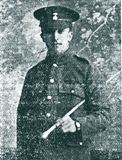
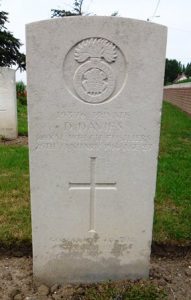
David Griffiths, Private, 73954, Sherwood Foresters. David was the son of Thomas Griffiths and Mary Griffiths (nee Beedle), of Haulfan, Ffridd Gate. The family was living at 4, Railway Side, Porth prior to the war, and David worked there as a warehouseman. He enlisted at Cardiff into the 3rd Battalion, Welsh Regiment on 6 March 1917 and upon completing his training was posted to No 5 Infantry Base Depot in France in May 1917, initially destined for the 18th Welsh. He was, instead, posted to the 19th Welsh on 19 June 1917. The battalion was in the Canal Bank sector at Ypres, with the 38th (Welsh) Division, and was building up ready to launch an assault on the Pilckem Ridge on 31 July. David survived the carnage of the Battle of Pilckem Ridge, and when the Division was relieved from the Ypres sector, he was transferred to the 10th Welsh. The Division then moved to positions near Armentieres, and took over a sector at Sailly-sur-la-Lys for the winter. The army was re-organised in at the end of January 1918, and the 10th Welsh received the unwelcome news that it was to be broken up, and its officers and men sent to rebuild other depleted units. David was initially posted to No 1 Entrenching Battalion on 27 February, and then on 1 April 1918 was posted to the 2nd Battalion, Sherwood Foresters, which was attached to 71 Brigade, 6th Division. The Division had suffered terrible casualties during the German Spring offensive and had just been moved to the Lys sector to rest, but became caught up in the second phase of the German Spring offensive, which was launched on the Lys Valley on 9 April, and got caught up in desperate fighting over the coming weeks. Once the offensive faltered, German attention turned south to the Aisne sector, so the battered Divisions to the north had a relatively quiet few months to recover. Following a brilliant victory during a combined Australian and Canadian attack at Villers Brettoneux on 8 August, attacks were launched at Albert on 21 August, before the Allies began pushing forwards all along the Western Front. The 6th Division took part in the Advance in Flanders, before moving south, where it took part in the advance on the Hindenburg Line. By 26 September, the 2nd Sherwood Foresters had moved into the Fresnoy-Gricourt sector and came under intermittent shellfire. On 28 September 1918 David was killed in action during a patrol during the day. He was 22 years old, and is buried in Vadencourt British Cemetery, Maissemy, France. His brother Richard was killed a month later.
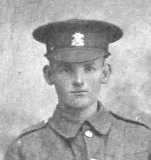
Richard Griffiths, Private, 69416, Royal Welsh Fusiliers. Richard was the son of Thomas Griffiths and Mary Griffiths (nee Beedle), of Haulfan, Ffridd Gate. The family was living at 4, Railway Side, Porth prior to the war, and Richard enlisted there into the Royal Welsh Fusiliers. Upon completing his training he was posted to Egypt and joined the 24th Battalion, Royal Welsh Fusiliers, which was in Palestine attached to 231 Brigade, 74th (Yeomanry) Division. Richard took part in the Divisions final actions in Palestine before it was transferred to France in May 1918. Upon arrival at Marseilles, the Division entrained for Northern France, and moved to Noyelles, where the Division detrained before moving to Doullens to begin a course of intensive training. On 26 June the 24th Battalion, Royal Welsh Fusiliers became one of three battalions transferred away from the 74th Division, and joined 94 Brigade, 31st Division in the Lynde area, moving to Morbecque. Over the coming weeks the Division remained in the same sector, the 24th RWF spending time repairing roads near Bailleul, but to the south, on 8 August 1918, a combined Australian and Canadian success at Villers-Brettoneux had broken the spirit of the German army, and from 21 August onwards the Allies began to advance. The 31st Division moved to Hill 63 on 5 September and began its advance from there on the following day. By 29 October the Division had reached Veerke, taking over the front line before advancing on Caster, and saw heavy fighting there on 31 October 1918. Richard was killed during the fighting that day. The 27-year-old is buried in Harlebeke New British Cemetery, Belgium.

Thomas James, Private, 23391, Royal Welsh Fusiliers. Thomas was the son of John and Elizabeth James, of Penrhyn Bach, Pennal. He was lodging with his two brothers, William and David, at the house of Ann Perrott at 25, John Street, Porth by 1911, and worked there as a Colliery Labourer. Thomas enlisted at Cardiff into the 16th Battalion, Royal Welsh Fusiliers, which had been raised at Llandudno by the Welsh National Executive Committee from a cadre from the 13th Battalion, joining 128 Brigade, 43rd (Welsh) Division and trained in North Wales before moving to Winchester in the summer of 1915, where the formation became renumbered 113 Brigade, 38th (Welsh) Division. The Division moved to France on 2 December 1915 and moved to the Nursery Sector near Fleurbaix for trench initiation alongside the Guards Division. The Division then held a sector of the line near Cuinchy before marching south to the Somme sector in June 1916 to take part in the assault on Mametz Wood. The first assault was launched on a one brigade front on 7 July, but failed, mainly due to inadequate artillery support, and the Divisional commander, Sir Ivor Philipps, was replaced before the Division attacked again on 10 July on a two brigade front, and after two days of intense fighting, the wood was almost cleared before the battered division was relieved and moved to Hébuterne to recover. Thomas had been badly wounded at Mametz Wood, and was evacuated along the chain of casualty clearing stations back to Beaufort War Hospital, Bristol, where he died of his wounds on 23 July 1916, aged 29. His remains were brought back home and he was buried in St. Peter and Vincula Churchyard, Pennal, his coffin being escorted by members of the Marconi Guard.
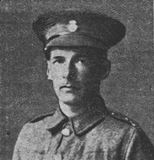
David Owen Jones, Gunner, 35459, Machine Gun Corps. David was the son of Owen and Jane Jones, of Gwyndy, Pennal. Both David and his father Owen were living at 95, Wood Street, Cilfynydd when war broke out, and David was working as a Collier. He enlisted at Pontypridd into the 21st Battalion, Royal Welsh Fusiliers on 12 December 1915 and was posted to Kinmel Park for training. David received specialist machine-gunner training, so was transferred to the Machine Gun Corps depot at Grantham on 28 February 1916. On 11 October 1916 David embarked at Devonport for Basra and disembarked there on 17 November, before joining the 132nd Company, Machine Gun Corps. Mesopotamia had been part of the mighty Ottoman Empire, but the discovery of oil had made it strategically important to Britain, so British troops had been sent to Abadan early in the war to guard oil supplies for the Royal Navy. The campaign slowly escalated, with the first major battle fought in April 1915, and by 1916 there was a powerful military presence in the country. In December General Maude launched a major offensive intending to seize Baghdad, and David, upon his arrival, joined this force. He was not in Mesopotamia long before he was severely wounded during fighting on 13 January 1917, and died that same day of his wounds. The 34-year-old has no known grave and is commemorated on the Basra Memorial, Iraq. He is also commemorated on the Pontypridd Roll of Honour.
Jones, E., Private. This man cannot presently be identified, but is possibly the man below:
Frank Jones, Private, DM2/075386, Royal Army Service Corps. Frank was the son of James and Emma Frances Jones, of Penrhynbach, Pennal. He had served during the war with the Royal Army Service Corps, and after the Armistice was living at Leach Street, Prestwich. He died at Warrington on 2 February 1919, aged 25. Frank is buried in St. Mary Churchyard, Prestwich, Lancs. The Pennal memorial shows an E. Jones, who cannot be identified, so could a mistake have been made in the lettering?
John Evan Jones, Private, 38504, Gloucester Regiment. John was born at Aberdyfi in 1899, the son of Joseph and Jane Jones. By 1911 both John and his mother Jane were under the care of Mr and Mrs William Lloyd, at Aberystwyth Poor Law Institution. He enlisted at Wrexham into the South Wales Borderers, and was posted to France at sometime after 1917, joining the 8th Battalion, Gloucestershire Regiment, which was attached to 57 Brigade, 19th (Western) Division. John probably joined the battalion after its exertions at Messines in 1917. The Division then fought on the Menin Road and at Polygon Wood, before moving up to Broodseinde, Poelcappelle and Passchendaele Village itself. In 1918 the Division was caught up in the German Spring Offensive near St. Quentin, where they suffered terrible casualties, taking part in a gallant rearguard action around Bapaume, before moving to Ypres to rebuild. Unfortunately the next phase of the German plan was a strike at Messines, to force a passage to the channel ports. John was killed during the German attack at Messines at some time between 9 and 18 April 1918. He was 18 years old, and is commemorated on the Tyne Cot Memorial, Belgium. (He is the only local man with the correct initials that the memorial states – J E Jones).
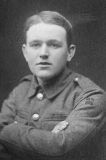
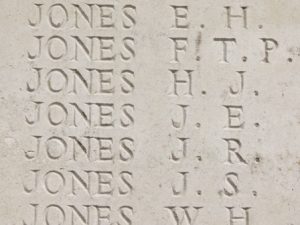
Thomas Jones, Private, 13271, Royal Welsh Fusiliers. Thomas was from Welshpool, but was living at Pennal by 1913, when he married Mary Catherine Roberts, of Ty Mawr, Pennal. He enlisted at Machynlleth into the 8th Battalion, Royal Welsh Fusiliers early after the start of the war and was sent to Wrexham, where the battalion formed prior to moving to Salisbury Plain, to join 40 Brigade, 13th (Western) Division. During July 1915 the Division embarked for Mudros, before landing at Cape Helles, Gallipoli on 16 July. The Division moved back to Mudros at the end of the month, and then on 4 August 1915 landed at Anzac Cove, to take part in the planned diversionary assault by the Anzacs on 6 August. The 13th Division saw heavy fighting here, but the offensive was largely unsuccessful, as was the main assault at Cape Helles, and ultimately the Gallipoli campaign got bogged down. Thomas’ health deteriorated during to the poor conditions at Gallipoli, and he died there of dysentery and syncope on 30 November 1915. He is buried in Hill 10 Cemetery, Gallipoli.
Arthur Moore Lascelles, VC, MC, Captain, Durham Light Infantry. Arthur was born at Streatham, London on 12 October 1880, the son of John Lascelles and Mary Elizabeth Lascelles (nee Cotton). The family moved to Penmaen Dyfi, near Pennal soon after his birth. Arthur was educated at Hillside School in Malvern, Uppingham School, Bangor University and Edinburgh University where he studied medicine. During 1902 he emigrated to South Africa and enlisted into the Cape Mounted Rifles on 11 August 1902. On 7 December 1907 he married Sophia Hardiman at Idutywa. Ronald saw action with the 1st South African Mounted Rifles during the German South West African Campaign following the outbreak of war, and in November 1915 returned to England, gaining a commission into the Durham Light Infantry, his late brothers’ regiment, on 28 December 1915. Following an Officer Training Course in Cambridge, he was posted to France, joining the 14th Battalion, Durham Light Infantry on the Somme on 16 July 1916. Two months later, on 18 September, he was wounded by shrapnel and evacuated to England for treatment. Upon recovery, he returned to France and served with the 11th Battalion, Durham Light Infantry before re-joining his old battalion, the 14th Durham Light Infantry on 9 June 1917. He was wounded again during a daytime trench raid soon afterwards, but was awarded the Military Cross and promoted Captain for his gallant efforts. He was hospitalised again, but had re-joined his battalion prior to the launching of the Battle of Cambrai. The Battle was launched on 20 November 1917 and was initially a success, but the Germans counter-attacked on 30 November and the Allies were forced to withdraw, after desperate fighting. During one of the German attacks, Arthur gained the award of the Victoria Cross, by displaying great courage. The citation to his award read:
‘For most conspicuous bravery, initiative and devotion to duty when in command of his company in a very exposed position. After a very heavy bombardment during which Captain Lascelles was wounded, the enemy attacked in strong force but was driven off, success being due to a great degree to the fine example set by this officer, who, refusing to allow his wound to be dressed, continued to encourage his men and organise the defence. Shortly afterwards the enemy again attacked and captured the trench, taking several of his men prisoners. Captain Lascelles at once jumped on to the parapet and followed by the remainder of his company, 12 men only, rushed across under very heavy machine-gun fire and drove over 60 of the enemy back, thereby saving a most critical situation. He was untiring in reorganising the position, but shortly afterwards the enemy again attacked and captured the trench and Captain Lascelles, who escaped later. The remarkable determination and gallantry of this officer in the course of operations, during which he received two further wounds, afforded an inspiring example to all.’
Arthur was again evacuated back to England for treatment, and upon recovering embarked for France, for what proved to be the final time, joining the 15th Battalion, Durham Light Infantry, which was attached to 64 Brigade, 21st (Light) Division, and was in the final stages of the war, advancing near Inchy. On 7 November 1918 the Division attacked the village of Limont-Fontaine, and Arthur was killed during the heavy fighting for the village. He was 38 years old and is buried in Dourlers Communal Cemetery Extension, France.
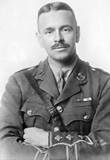
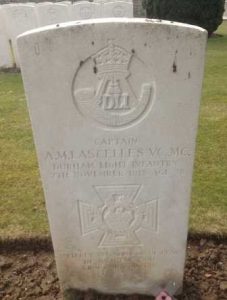
John Lewis, Private, 23808, Welsh Regiment. John was the son of Ann Lewis, of Pontybren Cwrt, Pennal. He had served during the Boer War with the South Wales Borderers, and after fifteen years’ service left the army to begin work in South Wales. Following the outbreak of war, John re-enlisted into the 16th Battalion, Welsh Regiment. The battalion was raised in Cardiff, before moving to Colwyn Bay, joining 130 Brigade, 43rd (Welsh) Division. After carrying out its basic training in North Wales, the Division moved to Winchester, where it became re-numbered as the 38th (Welsh) Division, and 130 Brigade became 115 Brigade. On 2 December 1915 John landed in France with the 16th Welsh, and the battalion moved to the Nursery Sector near Fleurbaix with the remainder of the Division, for trench initiation alongside the Guards Division. The Division then moved to the Cuinchy sector, before marching south to the Somme in June 1916 to take part in the great offensive, which was launched on 1 July. Here, the Division was given orders to attack and capture the largest wood on the Somme, Mametz Wood, so plans were drawn up to assault the wood from the south on a one Brigade front, and 115 Brigade was chosen for the task. At dawn on 7 July 1916, the attacking battalions of the Brigade, the 16th Welsh, and the 11th SWB began their advance without the cover of artillery, but both battalions were mown down by German machine-gun fire from The Hammerhead, suffering terrible casualties. John was among around 140 men killed with the 16th Welsh alone, while many more had been wounded. He has no known grave and is commemorated on the Thiepval Memorial, France.
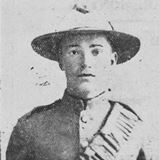
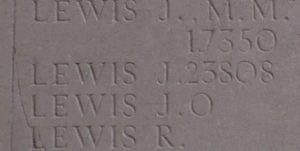
John Morgan, Gunner, 70127, Royal Garrison Artillery. John was the son of Thomas and Ann Morgan, of Pandy, Pantperthog. He worked as a postman prior to enlisting at Machynlleth into the Royal Garrison Artillery on 11 December 1915, and was mobilised on 17 March 1916, being posted to Fort Brockhurst, Gosport for training. He served with 116 Siege Battery on the Portland Garrison afterwards, before being posted to the East African Expeditionary Force, at Dar es Salaam, Tanzania on 19 August 1916. During April 1917 he contracted malaria and was hospitalised for three months before returning to duty and was posted to Lindi on 24 July, but had a relapse and was again hospitalised. On 15 October he was again discharged to duty, but then became ill again and was hospitalised at the 32nd British Stationary Hospital at Mtama, where he died of dysentery on 28 November 1917, aged 27. John is buried in Dar Es Salaam War Cemetery, Tanzania.
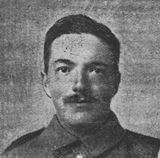
Richard James Morgan, Gunner, 118645, Royal Field Artillery. Richard was the son of David and Elizabeth Morgan, of Fron, Pennal. He worked at his father’s farm prior to the war, and enlisted into the Royal Field Artillery. After completing his training, he was posted to the 255th Brigade, Royal Field Artillery, which was attached to the 51st (Highland) Division. He probably joined his new unit on the Somme, where the 51st Division saw heavy fighting during the capture of Beaumont-Hamel on 13 November 1916. The Division remained on the Somme over the winter, before moving to Arras, taking part in the First Battle of the Scarpe. It then fought at the Second Battle of the Scarpe before being brought out of the line to rest, before taking part in an attack near Roeux, which the Division captured before moving north to Ypres. Here it took part in the opening assault of the Third Battle of Ypres, on 31 July 1917, at the Battle of Pilckem and helped advance the line towards Langemarck before being relieved and moving to the Cambrai sector. Richard was wounded soon after the move and was evacuated to the field ambulance at Acheux where he died of his wounds on 30 October 1917, aged 32. Richard is buried in Acheux British Cemetery, France.
Richard Pugh, Private, 2365, Welsh Regiment. Richard was the son of Griffith and Ann Pugh, of Tanyfron, Pennal. He worked in Gorseinon Steelworks prior to the war, and enlisted at Swansea into the 6th Battalion, Welsh Regiment. The battalion was a Territorial one, based in Swansea, and landed at Le Havre on 29 October 1914. Instead of being posted to the front, the battalion was instead put to work on Lines of Communication at Calais, for guard and fatigue duties. On 30 May 1915 a disaster struck the battalion. A party of men from the 6th Welsh were travelling in a motor lorry when it was hit by another, which sent it crashing into the canal. Richard and five other men from the battalion were sadly drowned in the tragedy. They were all buried side-by-side in Calais Southern Cemetery, France. Richard was 37 years old. His parents were later presented with a carved oak framed portrait of him by the Gorseinon Smelters Union.
Evan Bleddyn Rees, Corporal, 14238, Devonshire Regiment. Evan was the son of Evan and Jane Rees, of Gwynfryn, Pantperthog. He worked as a labourer prior to enlisting at Tonypandy into the 1st Battalion, Devonshire Regiment. The battalion had moved to France on 21 August 1914, initially joining 8 Brigade, 3rd Division, but at the end of September moved to 14 Brigade, 5th Division. Evan landed in France on 27 December 1914, joining the battalion in the Messines sector. He would have taken part in the Second Battle of Ypres in April 1915. Evan was probably wounded around this time, as he is recorded as having then been transferred to the 2nd Devons, and then to the 9th Battalion, Devonshire Regiment, which was attached to 20 Brigade, 7th Division. During the summer of 1916, the Division was on the Somme, and took part in the Battle of Albert, where it captured the village of Mametz. It then fought at the Battle of Bazentin, and the Attacks on High Wood, becoming the first troops into High Wood. The Division then took part in the Battle of Delville Wood, and the Battle of Guillemont, before spending the winter on the Ancre. In March 1917 the Division followed up the German Retreat to the Hindenburg Line, and fought alongside the Australians at the Battle of Bullecourt. Later in the year the Division moved to Ypres, and saw terrible fighting at the Battle of Polygon Wood. Evan was killed during the fighting to the east of the wood on 24 October 1917, aged 26. He is buried in Tyne Cot Cemetery, Belgium.
John James Rollins, Private, 29625, Royal Warwickshire Regiment. John was the son of Charles and Catherine Rollins, of Snitterfield, Stratford-on-Avon. He worked as a house painter prior to the war, and married Catherine Jones, of 2, Bryniau Bychan, Pennal, on 10 June 1909. John enlisted at Stratford-on-Avon into the Royal Warwickshire Regiment soon after the outbreak of war and was posted to the 1st Battalion, Royal Warwickshire Regiment at sometime in 1916. The battalion was in France attached to 10 Brigade, 4th Division, and saw heavy fighting on the Somme that summer. By early April 1917 the Division was at Arras, and fought at the First Battle of the Scarpe, and the Third Battle of the Scarpe, before moving to Ypres on 20 September, and undertook a short period of training behind the lines, before taking up positions at Iron Cross on the night of 3 October, to take part in the Third Battle of Ypres. The 1st Warwicks saw heavy fighting trying to advance the line near Langemarck over the coming days. John was killed in action here on 12 October 1917, aged 35. He has no known grave and is commemorated on the Tyne Cot Memorial, Belgium. His widow, Catherine, died at Bryncrug, Tywyn, on 4 March 1959. John is not commemorated locally.
Robert Williams, Sergeant, 290539, Royal Welsh Fusiliers. Robert was the son of David and Mary Ann Williams, of Talgarth Cottage, Pennal. He worked as a grocer at Porth Gwyn Stores prior to enlisting into the 7th Battalion, Royal Welsh Fusiliers at Tywyn on 7 August 1914. The battalion was a Territorial unit, which mobilised for war at Newtown in August 1914, as part of North Wales Brigade, Welsh Division and moved to Conway until the end of the month, before moving to Northampton. In December the Division moved to Cambridge and then in May 1915 to Bedford, where the Division was numbered and the formation became 158 Brigade, 53rd (Welsh) Division. On 19 July 1915 the entire Division sailed from Devonport for Imbros and on 9 August 1915 landed at Suvla Bay. The Division was eventually evacuated from Gallipoli in December 1915, moving to Egypt to join the EEF, and helped guard the Suez Canal before taking part in operations to drive the Turks out of the Sinai. The EEF then turned its attention onto driving the Turks out of Palestine, and on 26 March 1917 launched its first offensive against the coastal city of Gaza, which guarded the road to Jerusalem. Initial gains during the day were lost when the assaulting divisions lost touch with each other and communication broke down when a thick fog cloaked the battlefield. Robert was killed at some time during the days fighting. The 21-year-old has no known grave and is commemorated on the Jerusalem Memorial, Israel. He is also commemorated on the Tywyn War Memorial. (The CWGC records that Robert was killed on 26 February 1917, but this is an error).
Robert Williams, Private, 291270, Royal Welsh Fusiliers. Robert was the son of Robert and Elizabeth Williams, of Esgairgoch, Pennal. He enlisted at Tywyn into the 7th Battalion, Royal Welsh Fusiliers on 23 November 1915, and was posted to the 3/7th Battalion, Royal Welsh Fusiliers, at Park Hall, Oswestry, for his training. On 27 June 1916 he embarked for Egypt, joining the 1/7th Battalion, Royal Welsh Fusiliers, which was on the Suez Canal defences attached to 158 Brigade, 53rd (Welsh) Division. The Division had joined the EEF after several arduous months at Gallipoli, and helped clear the Turks out of the Sinai, before taking part in the advance into Palestine, and on 26 March 1917 took part in the First Battle of Gaza, an unsuccessful attempt to take the coastal city of Gaza and clear the way to Jerusalem. The battle failed due to poor communication, and a second offensive was launched on 17 April which also failed, and led to the commander of the EEF being replaced by Sir Edmund Allenby. A third offensive was launched on a wider front against Gaza and Beersheba on 1 November, which finally cleared the Turks and opened the way to Jerusalem, which was captured on 11 December. Robert was probably wounded during the advance north from here and died of his wounds on 29 December 1917, aged 20. He is buried in Jerusalem War Cemetery, Israel.
World War Two, 1939 – 1945
Stanley Jones, Serjeant, 14594404, The Queen’s Royal Regiment (West Surrey). Stanley was the son of Thomas and Anne Jones, of Pennal. He married Ethel Williams, in 1930, and the couple lived at 15, Doll Street, Machynlleth. (Ethel had lost her father, William Louis Williams, at Ypres in 1917). Stanley enlisted into the army and was posted to the 1st Battalion, The Queen’s Royal Regiment (West Surrey). The battalion was in India at the start of the war and fought for a year against tribesmen on the North-West Frontier. The battalion then transferred to Burma with the 7th Indian Division to take part in the fighting against the Japanese and saw much action in the Arakan, at Kohima and in the Irrawaddy operations. Stanley died in Burma on 27 July 1945, aged 37, just two months before VE Day. He is buried in Rangoon War Cemetery, Myanmar.
Idris Gwynfryn Lewis, Private, 7362755, Royal Army Medical Corps. Idris was born on 20 December 1918, the son of Lewis and Margaret Anne Lewis, of Machynlleth. He lived at Talgarth Cottage prior to the war, when he enlisted into the Royal Army Medical Corps. After completing his training, Idris was posted to ‘A’ Company, 132 Field Ambulance, RAMC and was probably posted out to North Africa with the unit, before it took part in the landings in Italy in 1943. Idris died in Italy on 11 October 1944, aged 25. He is buried in Faenza War Cemetery, Italy.
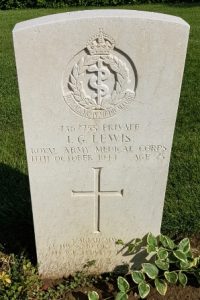
Edmund Wybergh Thruston, DSC, Commander, Royal Navy. Edmund was born on 6 December 1903, the son of Lieutenant Colonel Edmund Heathcote Thruston and Lucy Thruston (nee Lawson), of Pennal Tower, Pennal. He enlisted into the Royal Navy on 15 November 1917 and served with the Royal Navy during the entire inter-war period. Edmund was posted to Australia prior to the war, being seconded to the Royal Australian Navy, and married Nina Dorothy Nisbet, of Darling Point, in Sydney on 22 January 1940. Edmund served aboard the Leander-class light cruiser HMAS Sydney. She was built by Swan Hunter and had seen extensive service following her launch in 1934. Following the outbreak of war, Sydney carried out duties in Australian waters, before moving to the Mediterranean in May 1940, where she fired her guns in anger for the first time. Sydney saw plenty of action during about ten months service in the Mediterranean, before returning to Australia in February 1941 to resume patrols in home waters. On the afternoon of 19 November 1941, Sydney was off the coast of Western Australia when she spotted a merchant ship which turned away, so she increased speed to intercept. False signals were hoisted by the merchant ship, which turned out to be the German auxiliary cruiser Kormoran in disguise, and the Germans opened fire on the unsuspecting Sydney, who returned fire. An intensive fight then ensued between the two ships, and at some time during the night, 20 November 1941, the crippled Sydney sank with the loss of 645 lives. The German ship, Kormoran, was also badly crippled, and sank on the following day. Edmund was 37 years old when he was killed during the loss of HMAS Sydney. He is commemorated on the Chatham Naval Memorial, Kent and on a plaque inside St. Peter’s Church, Pennal, but is not named on the main war memorial.
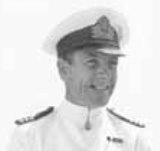
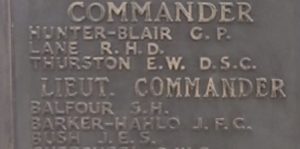
Hugh Thomas Wynne, Gunner, 4205796, Royal Artillery. Hugh was born on 11 November 1911, the son of John Wynne and Jane Wynne (nee Arthur), of Machynlleth. He married Gwen May Davies, of Pennal, in 1939. Hugh enlisted into the Royal Artillery and after completing his training was posted to 380 Battery, 116 Light Anti-Aircraft Regiment, which was attached to the 53rd (Welsh) Division. The Division spent most of the war on home service, but at the end of June 1944 landed in Normandy, to take part in the break-out. The regiment set up its guns soon after arriving in France, to defend against air attack, but it soon became apparent that the Luftwaffe was almost finished, so the regiment was also used against ground targets. Hugh became the first member of the regiment to be killed, losing his life when his battery was shelled on 1 July 1944. He was 32 years old and is buried in Ryes War Cemetery, Bazenville, France.
